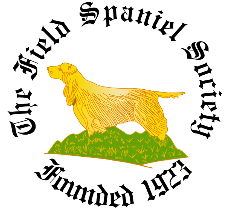
The Field Spaniel Society
We welcome comments or suggestions about the Web Site. Please forward to the webmaster using the email link below

Copyright © 2024 - Field Spaniel Society. All Rights Reserved. Material may be copied from this website for personal use only & must not be reproduced or published without the written permission of the Field Spaniel Society

Breed Standard
A Breed Standard is the guideline which describes the ideal characteristics, temperament and appearance including the correct colour of a breed and ensures that the breed is fit for function. Absolute soundness is essential. Breeders and judges should at all times be careful to avoid obvious conditions or exaggerations which would be detrimental in any way to the health, welfare or soundness of this breed. From time to time certain conditions or exaggerations may be considered to have the potential to affect dogs in some breeds adversely, and judges and breeders are requested to refer to the Breed Watch section of the Kennel Club website here https://www.thekennelclub.org.uk/services/public/breed/watch for details of any such current issues. If a feature or quality is desirable it should only be present in the right measure. However if a dog possesses a feature, characteristic or colour described as highly undesirable it must not be rewarded in the show ring.
General Appearance
A well balanced, noble, upstanding sporting Spaniel built for activity and endurance.
Characteristics
Ideal for rough shooting or as a companion for the country dweller. Not suitable for the city.
Temperament
Unusually docile, active, sensitive,independent.
Head and Skull
Conveys the impression of high breeding, character and nobility. Well chiselled, occiput well defined, lean beneath the eyes. A thickness here gives coarseness to the whole head. Slightly raised eyebrows. Moderate stop. Nose well developed with good open nostrils. Muzzle long and lean neither snipy nor squarely cut. In profile curving gradually from nose to throat.
Eyes
Wide open but almond-shaped with tight lids showing no haw. Grave and gentle in expression. Dark hazel in colour.
Ears
Moderately long and wide, set low and well feathered.
Mouth
Jaws strong with a perfect, regular and complete scissor bite. i.e. upper teeth closely overlapping lower teeth and set square to the jaws.
Neck
Long, strong and muscular enabling dog to retrieve his game without undue fatigue.
Forequarters
Shoulders long and sloping and well laid back. Legs of moderate length. Straight, flat bone.
Body
Chest deep and well developed. Ribs moderately well sprung. Length of ribcage is two-thirds of the body length. Back and loin strong, level and muscular.
Hindquarters
Strong, muscular; stifles moderately bent. Hocks well let down.
Feet
Tight, round with strong pads and not too small.
Tail
Previously, customarily docked. Docked:. Set on low. Never carried above the level of the back. Nicely feathered, with lively action. Previously,customarily docked by one third. Undocked: Set low. Never carried above the level of the back. Nicely feathered with lively action. Reaches approximately to the hocks. Of moderate length in balance with the rest of the dog.
Gait/Movement
Long, unhurried stride with great drive from the rear. Short stumping action undesirable.
Coat
Long, flat, glossy and silky in texture. Never curly, short or wiry. Dense and weatherproof. Abundant feathering on chest, under body and behind legs, but clean from hock to ground.
Colour
Black, black and tan, blue roan, blue roan and tan, liver, liver and tan, liver roan, liver roan and tan. In solid-coloured dogs, white or roan on chest is permissible. All other colours, including clear black and white, clear liver and white, orange, red, golden or sable highly undesirable. (See introductory paragraph).
Size
Height: approximately 46cms (18ins) at the shoulders. Weight between 18-25 kgs (40-55 Lbs).
Faults
Any departure from the foregoing points should be considered a fault and the seriousness with which the fault should be regarded should be in exact proportion to its degree. and its effect upon the health and welfare of the dog and on the dog’s ability to perform its traditional work.
Note: Male animals should have two apparently normal testicles fully descended into the scrotum.
Published with kind permission from The Kennel Club © The Kennel Club
The Kennel Club Breed Standard
| Introduction to the Field Spaniel |
| KC Website Breed Information |
| Breed Standard |
| Illustrated Breed Standard |
| Officers and Committee |
| Club Information |
| Membership |
| Code of Ethics |
| Breeders Charter |
| Year Book Details |
| Judges Forms & Judges Lists |
| A1 A2 & A3 Judges List Criteria |
| B List Criteria |
| C List Criteria |
| A1 Judges List |
| A2 Judges List |
| A3 Judges List |
| B Judges List |
| C Judges List |
| L2 Judges List |
| Annual Points Trophy Winners |
| Show Calendars 2011 to 2026 |
| Show Calendars 1999 to 2010 |
| Bitch CC Winners 1923-1950 |
| Bitch CC Winners 1951-1984 |
| Bitch CC Winners 1985-Ongoing |
| Dog CC Winners 1923-1950 |
| Dog CC Winners 1951-1984 |
| Dog CC Winners 1985-Ongoing |
| Health |
| Heart Testing Info |
| Hip Dysplasia Scheme Page |
| Eye Testing |
| Health Seminar 2016 |
| Health Seminar 2017 |
| Guide to Working a Field Spaniel |